Papers by Joshua Earnest
2013 IEEE Frontiers in Education Conference (FIE), 2013
broad-based engineering diploma programmes for the post-16 year olds. With technological advancem... more broad-based engineering diploma programmes for the post-16 year olds. With technological advancements in the industry, they now require in the passouts of these technical colleges a spectrum of core competencies, hitherto not required. How to respond to this scenario was the question. The competencybased curriculum was propounded as one strategy to fulfil their labour market demands. Though world-wide, various competence models were being used by different education and training organisations for specific job-oriented courses, blind copying of these were not found suitable for these unique engineering diploma programmes. This necessitated the analyses of various competence models resulting in the custom-designed ‘TTTI- St. Xavier Model ’ competency-based curriculum for this technical college system and experimented
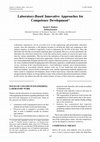
Laboratory experiences can be powerful tools in the engineering and polytechnic education system,... more Laboratory experiences can be powerful tools in the engineering and polytechnic education system, since the laboratory is the primary location to develop the skills and competences that industry requires. A student is expected to work in a laboratory for 40-50% of the time. Thus, the laboratory has become an extremely important place of learning. However, at most institutions, the laboratory has often been found to be a weak link and has been a matter of concern for quite some time for various stakeholders. This has led to the realisation of the need to make laboratory work more effective by bringing in innovative approaches. Various areas of laboratory innovations that have been purposefully designed and directed to improve laboratory practices are examined in this article. Areas considered include designing innovative laboratory experiences, modifications in experimental set-up, variations in the experimental process, visual laboratory manuals, micro-demonstrations, improvements i...
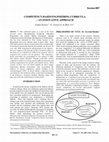
1 Joshua Earnest, Professor & Head, Electrical Engineering, Technical Teachers' Training Inst... more 1 Joshua Earnest, Professor & Head, Electrical Engineering, Technical Teachers' Training Institute, Bhopal 462 002, Madhya Pradesh, India. joshuaearnest@hotmail.com, joshuaearnest@rediffmail.com 2 B Fr. Francis E. de Melo, S.J., Principal, St. Xavier’s Technical Institute, Mahim, Mumbai – 400 016, India. francis@xaviertech.com Abstract This condensed paper is a part of the large doctoral thesis 'Reengineering Technician Education Programmes for Labour Market Orientation through Competency-based Curriculum Development in Polytechnics’ that has been submitted by Prof. Joshua Earnest to the Barkatullah University, Bhopal, India in April, 2001. About 1650 odd technical colleges (called polytechnics in India) offer broad-based engineering diploma programmes for the post-16 year olds. With technological advancements in the industry, they now require in the passouts of these technical colleges a spectrum of core competencies, hitherto not required. How to respond to this scenario...
2019 ASEE Annual Conference & Exposition Proceedings
He has authored a book on 'Competency-Based Curriculum Development', published 2 modules ... more He has authored a book on 'Competency-Based Curriculum Development', published 2 modules in engineering education related areas along with other colleagues of NITTTR Bhopal. He has also published several international papers related to engineering education over the past several years. He has also authored 2 popular books on wind power technology-one focused for the industry and the other for the university system. He was the first professor in India to offer online training programs for inservice engineering teachers in the areas wind power and renewable energy since 2005.
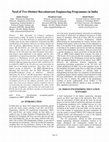
University News - University Journal of Higher Education, New Delhi, India, 2018
With thousands of technical institutions mushrooming in India, the quality of engineerig educatio... more With thousands of technical institutions mushrooming in India, the quality of engineerig education is going down. 4-year Baccalaureates in engineering education in India going by the names of Bachelor of Engineering (BE) and Bachelor of Technology (B.Tech.) are being churned out with no distinct differentiation between the two different names. BE and B.Tech. are terms that are interchangeably used in India, and are also often confused with each other Whereas, in the USA and some other European Universities, both degrees mean differently to the industry and the other stakeholders of engineering education. With India becoming a signatory to Washington Accord, and unemployablility of engineers at the lowest levels, it is all the more urgent to offer distinctly different engineering degrees (B.E. and B.Tech.) as accredited by ABET in the US and even some universities in India, but in the Indian perspective. Since there there two distinct groups of industries-the MMS (Manufacturing, Mrketing and Servicing) and the R&D (Research and Design/Development) group of industries-distinctly bifurcating the B.Tech. and BE programmes offerings with two distinct sets of competencie/ skill-sets as required by the respective group of industries is the need of the hour. During recruitment process by the industry presently, most of the times, they come across medicore generic engineers who are not possessing the necessary competencies for either of the two groups of industries and are also not work-ready to be directly put on the jobs. All these concepts are discussed and argued out in this paper.

In India, unlike the Western world, the universities have several engineering institutes affiliat... more In India, unlike the Western world, the universities have several engineering institutes affiliated to them that are geographically spread across large provinces. Gujarat Technological University (GTU) is one such example, that caters to the technical education needs of the state of Gujarat (size of
Arizona) with a population of 65 million. More than one hundred such institutes offering undergraduate and graduate programs and about same number of ‘Polytechnics’ offering engineering diploma programs are affiliated to GTU. Around 100 thousand students take admissions every year in the 55 different technology programs being offered. Since examination and certification is the main responsibility of the University, it becomes necessary to conduct centrally administered end-of-the-term examinations every semester. This necessitates the curriculum for each program to be same in all the institutes. Hence, curriculum design became a centralized task to address the needs of today’s globalized industry and also fulfill the aspirations and capabilities of the students, belonging to different strata of the society. Since curriculum designers and implementers are not the same in this experiment, a need-based curriculum model became imperative to be developed that could convey clearly and uniformly the intentions of the designers in letter and spirit to all curriculum implementers and stakeholders.
In this backdrop, NITTTR Bhopal one of the four premium
institutes established by the Government of India for quality
improvement of the technical education, was assigned the task by GTU in 2012 to completely re-design the curriculum of twenty five engineering diploma programs to produce ‘work ready’ personnel. The authors were the core members of the core team who undertook this task. This paper highlights the challenges and opportunities faced by the engineering education system due to fast changes taking place in society, industry and education, for which an innovative outcome-based curriculum model was evolved to address these challenges and harness the opportunities. This paper discusses the various facets of the philosophy, approach and structure of this curriculum model evolved for this purpose. It also briefly describes the planning, designing, implementation and evaluation of the curriculum development process, as well as some of the strategies adapted in this innovative curriculum model.
In the summer 2006 the course Windpower Basics was offered by National Technical Teachers Trainin... more In the summer 2006 the course Windpower Basics was offered by National Technical Teachers Training Institute in Bhopal, India in cooperation with Gotland University in Sweden, that made the course material available on it's Internet platform. On this platform an e-classroom was prepared, that contained all the course material; articles, exercises and tests. The course ran for two weeks, full time, on the NITTTR campus. Gotland University has run Windpower Basics as a regular university level distance education course, on half time basis, with trainees from many parts of the world. This combination of the distance education platform and a full time campus course was an interesting experience. This concept could be developed into a worldwide windpower education network.
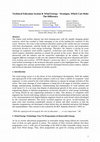
The Indian wind turbine industry has been keeping pace with the rapidly changing global scenario,... more The Indian wind turbine industry has been keeping pace with the rapidly changing global scenario, which has resulted in India emerging as one of the leading five countries in this sector. However, the irony is that technical education system of the country has not resonated with these developments, whereby hardly any institute is offering courses and programmes exclusively devoted to wind energy technology. Therefore, the industry is facing an acute shortage of competent wind turbine engineers, technicians and artisans. This is an issue, which requires immediate attention to sustain the growth of this sector. Based on the close interaction with the industry and the researches undertaken by the authors, this paper suggests different strategies to tide over this situation through long-term education and short-term training interventions. NITTTR Bhopal’s pioneering efforts to establish this emerging wind turbine technology in the technical education system is also highlighted here. This paper also suggests how synergic partnerships could be developed between policy makers, industry and technical education institutions for further growth
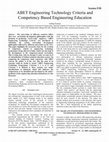
The universities in different countries follow their own curriculum development philosophies with... more The universities in different countries follow their own curriculum development philosophies with the intention of producing "work-ready" engineers. "ABET Engineering Technology Criteria" was introduced to rationalise the various curriculum development philosophies followed by different universities in the USA. This paper highlights the researches done for the creation of competency related to engineering technology programmes being offered in India, which can also help in the development of the competency-based curriculum. This is being done with an attempt to usher in some level of rationalisation of Indian technical education system. On comparing the competency bank experience with ABET criteria, the author is of the view that the some of its concepts could be useful to enrich "ABET Engineering Technology Programmes Criterion # 2 'a to k' and Criterion # 8. Related to these concpts, two major classifications of industries which also influence the competencies to be identified and developed in the undergraduates of the engineering education institutions are also discussed.
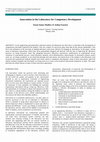
ABSTRACT: In the engineering and polytechnic education system, the laboratory has often been a we... more ABSTRACT: In the engineering and polytechnic education system, the laboratory has often been a weak link in the development of competencies and skills required by the industry. This was a matter of concern for quite some time by the various stakeholders. This led to the realization of the necessity of making laboratory work more effective by bringing in innovations. In this paper, various areas of laboratory innovations, which have been purposefully designed and directed, with the aim of improving the laboratory practices are being discussed. Areas like designing innovative laboratory experiences; modifications in experimental set-up; variations in experimental process; visual laboratory manuals; micro-demonstration; improvements in assessment scheme; project work; etc. are being considered. It was found that through such innovations, the interest level of the students in the laboratory work increased and experimental methods adopted were better suited to competency development. Some of these innovations, which the authors initiated, designed and developed, are being tried out in some of the technical educational institutions in India. This paper describes the salient features of many of these innovative approaches.
The premise of this experiment was that, if the teachers takes the student through such graded la... more The premise of this experiment was that, if the teachers takes the student through such graded laboratory experiments, the student is progressively encouraged to leave full dependence on the teacher in undertaking experiments and become fully competent in performing independently these skills/competencies that are generally an integral part of small/large projects when the student enters the 'world of work'. This philosophy further renders the transition towards full independence to be smooth from 'full dependence' on the teacher to 'full independence', thereby allowing comparatively lesser 'educational jerks'. The salient features of the design of these experiments, its benefits to the students and teachers are discussed in this paper.
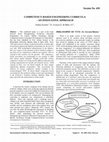
This condensed paper is a part of the large doctoral thesis 'Reengineering Technician Education P... more This condensed paper is a part of the large doctoral thesis 'Reengineering Technician Education Programmes for Labour Market Orientation through Competency-based Curriculum Development in Polytechnics’ that has been submitted by Prof. Joshua Earnest to the Barkatullah University, Bhopal, India in April, 2001. About 1650 odd technical colleges (called polytechnics in India) offer broad-based engineering diploma programmes for the post-16 year olds. With technological advancements in the industry, they now require in the passouts of these technical colleges a spectrum of core competencies, hitherto not required. How to respond to this scenario was the question. The competency-based curriculum was propounded as one strategy to fulfil their labour market demands. Though world-wide, various competence models were being used by different education and training organisations for specific job-oriented courses, blind copying of these were not found suitable for these unique engineering diploma programmes. This necessitated the analyses of various competence models resulting in the custom-designed ‘TTTI - St. Xavier Model’ competency-based curriculum for this technical college system and experimented in the St.Xavier’s Technical Institute, Mumbai, India. This paper describes the salient features of this model.
Conference Presentations by Joshua Earnest

Annual FIE Conference Proceedings, 2012
In India, unlike the Western world, the universities have several engineering institutes affiliat... more In India, unlike the Western world, the universities have several engineering institutes affiliated to them that are geographically spread across large provinces. Gujarat Technological University (GTU) is one such example, that caters to the technical education needs of the state of Gujarat (size of Arizona) with a population of 65 million. More than one hundred such institutes offering undergraduate and graduate programs and about same number of 'Polytechnics' offering engineering diploma programs are affiliated to GTU. Around 100 thousand students take admissions every year in the 55 different technology programs being offered. Since examination and certification is the main responsibility of the University, it becomes necessary to conduct centrally administered end-of-the-term examinations every semester. This necessitates the curriculum for each program to be same in all the institutes. Hence, curriculum design became a centralized task to address the needs of today's globalized industry and also fulfill the aspirations and capabilities of the students, belonging to different strata of the society. Since curriculum designers and implementers are not the same in this experiment, a need-based curriculum model became imperative to be developed that could convey clearly and uniformly the intentions of the designers in letter and spirit to all curriculum implementers and stakeholders. In this backdrop, NITTTR Bhopal one of the four premium institutes established by the Government of India for quality improvement of the technical education, was assigned the task by GTU in 2012 to completely redesign the curriculum of twenty five engineering diploma programs to produce 'work ready' personnel. The authors were the core members of the core team who undertook this task. This paper highlights the challenges and opportunities faced by the engineering education system due to fast changes taking place in society, industry and education, for which an innovative outcome-based curriculum model was evolved to address these challenges and harness the opportunities. This paper discusses the various facets of the philosophy, approach and structure of this curriculum model evolved for this purpose. It also briefly describes the planning, designing, implementation and evaluation of the curriculum development process, as well as some of the strategies adapted in this innovative curriculum model.
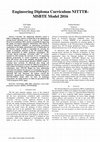
FIE Annual Conference Proceedings, 2016
Currently, the engineering education system is India is undergoing a massive overhaul due to the ... more Currently, the engineering education system is India is undergoing a massive overhaul due to the adaptation of outcome-based education across the country by the National Board of Accreditation (NBA) which is responsible for improving the quality of technical education. Maharashtra State Board of Technical Education (MSBTE), an autonomous government organisation in the highly industrialised state of Maharashtra in the Western region of India is responsible for ensuring the quality of technology education in the 550 technical colleges (called polytechnics in India) producing technologists. The currently offered technology curriculum called "G" scheme launched in 2012 includes the curricula of over 18 engineering diploma programmes of various occupations, comprising of about 450 courses. Due to the anomalies and lacunae of these curricula visa -vis outcome-based education MSBTE needed to redesign these curricula. To effectively plan, design and implement outcome-based curricula for different occupations in large number of institutes is always a daunting challenge for any organisation. Since NITTTR Bhopal has been undertaking curriculum development for the past several decades for various technology programmes, MSBTE entrusted NITTTR Bhopal to undertake this task. Therefore, the authors evolved the innovative outcome-based "Engineering Diploma Curriculum NITTTR-MSBTE Model 2016" for these 18 technology programmes, the salient features of which are presented in this "work in progress (WIP)" paper.
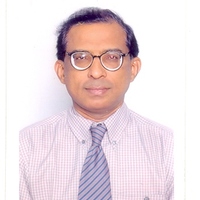










Uploads
Papers by Joshua Earnest
Arizona) with a population of 65 million. More than one hundred such institutes offering undergraduate and graduate programs and about same number of ‘Polytechnics’ offering engineering diploma programs are affiliated to GTU. Around 100 thousand students take admissions every year in the 55 different technology programs being offered. Since examination and certification is the main responsibility of the University, it becomes necessary to conduct centrally administered end-of-the-term examinations every semester. This necessitates the curriculum for each program to be same in all the institutes. Hence, curriculum design became a centralized task to address the needs of today’s globalized industry and also fulfill the aspirations and capabilities of the students, belonging to different strata of the society. Since curriculum designers and implementers are not the same in this experiment, a need-based curriculum model became imperative to be developed that could convey clearly and uniformly the intentions of the designers in letter and spirit to all curriculum implementers and stakeholders.
In this backdrop, NITTTR Bhopal one of the four premium
institutes established by the Government of India for quality
improvement of the technical education, was assigned the task by GTU in 2012 to completely re-design the curriculum of twenty five engineering diploma programs to produce ‘work ready’ personnel. The authors were the core members of the core team who undertook this task. This paper highlights the challenges and opportunities faced by the engineering education system due to fast changes taking place in society, industry and education, for which an innovative outcome-based curriculum model was evolved to address these challenges and harness the opportunities. This paper discusses the various facets of the philosophy, approach and structure of this curriculum model evolved for this purpose. It also briefly describes the planning, designing, implementation and evaluation of the curriculum development process, as well as some of the strategies adapted in this innovative curriculum model.
Conference Presentations by Joshua Earnest
Arizona) with a population of 65 million. More than one hundred such institutes offering undergraduate and graduate programs and about same number of ‘Polytechnics’ offering engineering diploma programs are affiliated to GTU. Around 100 thousand students take admissions every year in the 55 different technology programs being offered. Since examination and certification is the main responsibility of the University, it becomes necessary to conduct centrally administered end-of-the-term examinations every semester. This necessitates the curriculum for each program to be same in all the institutes. Hence, curriculum design became a centralized task to address the needs of today’s globalized industry and also fulfill the aspirations and capabilities of the students, belonging to different strata of the society. Since curriculum designers and implementers are not the same in this experiment, a need-based curriculum model became imperative to be developed that could convey clearly and uniformly the intentions of the designers in letter and spirit to all curriculum implementers and stakeholders.
In this backdrop, NITTTR Bhopal one of the four premium
institutes established by the Government of India for quality
improvement of the technical education, was assigned the task by GTU in 2012 to completely re-design the curriculum of twenty five engineering diploma programs to produce ‘work ready’ personnel. The authors were the core members of the core team who undertook this task. This paper highlights the challenges and opportunities faced by the engineering education system due to fast changes taking place in society, industry and education, for which an innovative outcome-based curriculum model was evolved to address these challenges and harness the opportunities. This paper discusses the various facets of the philosophy, approach and structure of this curriculum model evolved for this purpose. It also briefly describes the planning, designing, implementation and evaluation of the curriculum development process, as well as some of the strategies adapted in this innovative curriculum model.